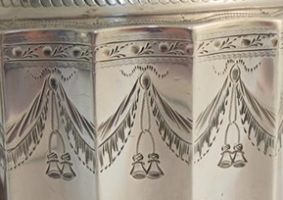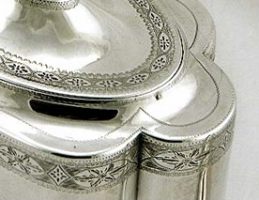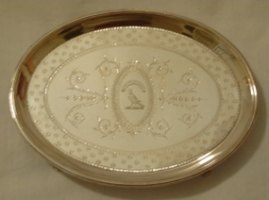by Joanne
and Emmett Eldred
(click on photos to enlarge image)
COLLECTING SILVER TEAPOTS AND STANDS
OUR COLLECTING GUIDELINES (3)
The following is the third in a series of papers, which
discuss several of the criteria we use in evaluating pieces we
collect. These discussions will highlight our approach when
considering form, originality of teapot and stand combinations,
engraving, hallmarks, condition, and crests & coats-of-arms. In
most cases we have used pictures from our modest but growing
collection to illustrate what is being described.
As is the case with collecting almost anything, the initial
learning curve can be quite steep. Being fairly new to the
subject it certainly applied to us. Our initial screen involved
only two basic areas; form and hallmarks. Our assessment of form
was subjective and based solely on our personal tastes at the
time. Of course having seen only a few examples we did not have
a broad reference base and therefore were unaware of the variety
of designs produced during the later part of the 18th century.
Our second screen was centered on hallmarks. As noted earlier,
one advantage in collecting English silver is its hallmarking
system. Fortunately we were able to locate several excellent
Websites for researching hallmarks, especially maker's marks.
Looking back on things we were very lucky with the majority of
our early purchases. We could have made some costly mistakes
because we did not realize that several other key factors, such
as crispness of the engraving, absence of repairs, surface
patina, presence of an identifiable coat-of-arms or crest, etc.,
significantly contributed to the desirability and therefore the
value of a set.
Over time we became more knowledgeable and ultimately developed
a pretty rigorous set of criteria for evaluating pieces we were
interested in purchasing. Our approach currently involves a
number of assessments (form, originality, engraving, hallmarks,
condition, crest), which we will describe over a series of
articles.
Part 3: ENGRAVING
Since we prefer pieces with armorial arms or crests, many of
the pieces we are considering have engraving.
The condition of the engraving is very important since it is key
component of the overall design statement. In evaluating
condition, we use a scale of 1-10, with 1 meaning the engraving
is barely discernable and 10 indicating it is almost perfect. We
would not typically purchase something with a rating of less
than 7. That means that all components of the engraving are
clearly visible and the only wear is where the engraving runs
over edges (and is prone to wear from polishing) or comes in
contact with another surface during normal usage. It also means
that any fine background lines are still present but maybe
slightly worn in spots (they tended to be cut very shallow).
The following are some examples to illustrate the point (obviously
it is better to actually handle the pieces, but hopefully the
pictures convey the general condition of the engravings.)

Wear to tray from contact with the teapot
(grade 7)
|

Very crisp with slight wear on ridges
(grade 8-9)
|

Very crisp with almost no wear (grade 9)
|

Very crisp with virtually no wear (grade 9-10)
|
It is important to remember that most of the silver was
polished frequently over its lifetime. This was especially true
if its owner’s household had staff. Wear to the engravings from
polishing came from two sources. First was the abrasive nature
of the polishes they used, which varied considerably in the late
18th and early 19th centuries. These abrasive polishes removed
layers of silver more or less uniformly across the surfaces
being polished. Of course engravings held tarnish and thus were
areas of more concentrated polishing. The other was the frequent
removal of tarnish. Since tarnish is the chemical combination of
silver and sulfur (sulfur in household air coming from
combustion and/or emanating from things such as wool rugs,
rubber, etc.), its removal also removes small amounts of silver.
Over time, this can result in a rounding over of the edges of
the bright-cut engraving, which also leads to a loss of
crispness. Likely, the examples that have the best preserved
engravings were those that were either wiped frequently before
tarnish could form or those that were severely tarnished due to
infrequent polishing (once a tarnish film covers the piece it
acts as a sort of barrier against additional tarnishing).
It is also important to determine if the engravings on the
teapot and stand match and ideally whether they are contemporary
to the teapot and stand. This again becomes fairly subjective.
Typically we research the overall background engraving against
other examples of a silversmith's work. This is straightforward
for pieces crafted by Henry Chawner, the Hennells, or the
Batemans since they were fairly prolific and we have a large
number of reference photographs for each of these makers. It is
obviously more difficult for other less well known makers since
examples of their work are harder to find. After considerable
study of pieces made by Chawner, Hennell, and Bateman, it became
apparent that individual makers seemed to prefer certain
engraving designs. For example, the engravings on Hester Bateman
pieces routinely have floral patterns while those of Chawner and
Hennell are more varied. It is likely that each silversmith had
drawings or actual examples of different engraving patterns in
their workshops. This would have aided customers and/or the
silversmith in their selection of a design, especially if the
engraving was to be contracted outside the shop (likely the case
for many of the smaller shops since it is doubtful that most
silversmiths did their own engraving and they probably did not
have engravers resident in their shop.)
It is possible that the teapots and stands were sometimes
engraved by different individuals, especially if they were made
at different times. However, engravers of the period seemed to
be routinely competent so it is pretty hard to discern
differences based on technique. Also, an engraver might have
unintentionally altered a pattern slightly between a teapot and
stand. This could be easily understood, especially if he was
working from a drawing or memory rather that actually having the
companion piece in front of him for reference. In general, what
we try to look for is significant differences in the design or
quality of the engravings between the teapot and stand.
We find it harder to tell if a crest or coat-of-arms was
engraved at the same time as the overall background engraving.
It seems that the convention during the period was to add the
crest or coat-of-arms to only to the stand and the right-facing
side of the teapot (spout facing to the right). This is logical
since one of the major reason for adding initials, monograms, or
crests/arms was for identification (e.g., if the pieces were
stolen.) On the other hand, it might just have been for economic
reasons. Why spend extra to have both sides engraved since only
one side was typically visible when it was displayed, or if
someone were right handed, the crest would face out when the
teapot was being held? However, there were likely numerous
exceptions.
It is well documented that displaying family crests was very
popular throughout most of the 19th century and there were a
large number of very proficient engravers working throughout
this period. We have a simple drum shaped Henry Chawner set with
almost no engraving except for relatively elaborate cartouches
on both the teapot and stand. There is little doubt the
cartouches are contemporary with the pieces (we have several
references of an identical cartouche being used on several other
Chawner pieces at around the same time – possibly done by the
same engraver.) There is a family crest inside the cartouches on
both sides of the teapot as well as on the stand. The crests
appear to be contemporary with the cartouches, however it is our
suspicion they were probably added a decade or so later when the
family coat-of-arms was passed to a cousin because of a lack of
a male heir.
However there are instances where it is almost certain that a
crest was engraved at the same time as the overall background
engraving. For example, we have a 1791 Henry Chawner teapot and
stand with a Calley family crest in the cartouches on the stand
and on the right-facing side of the teapot. Interestingly it has
a smaller exact duplicate crest integrated into the double-dot
border design of the lid. There are obvious variations in the
spacing of the dots leading up to the bottom "wreath" of the
crest, which indicates the crest was probably engraved first and
the border added afterwards.
Henry Chalmer teapot and stand 1791 (left) and
Calley family crest on teapot and stand (right)
|
Small Calley family crest integrated with the
double-dot pattern surrounding the lid
|
Another Hester Bateman piece has an open cartouche on the
right side, which never had a crest but a full Halliwell family
coat-of-arms with crest on the opposite side. The piece might
have been planned this way since usually matching cartouches are
present on both sides, but since there is nothing engraved in
the cartouche, it is likely the crest was added a bit later.
Joanne and Emmett Eldred
- 2011 -
|
|
|

